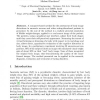Free Online Productivity Tools
i2Speak
i2Symbol
i2OCR
iTex2Img
iWeb2Print
iWeb2Shot
i2Type
iPdf2Split
iPdf2Merge
i2Bopomofo
i2Arabic
i2Style
i2Image
i2PDF
iLatex2Rtf
Sci2ools
78
Voted
MICCAI
2000
Springer
2000
Springer
Computer-Based Assessment of Body Image Distortion in Anorexia Nervosa Patients
A computer-based method for the assessment of body image distortions in anorexia nervosa and other eating-disordered patients is presented. At the core of the method is a realistic pictorial simulation of lifelike weight-changes, applied to a real source image of the patient. The patients, using a graphical user interface, adjust their body shapes until they meet their self-perceived appearance. Measuring the extent of virtual fattening or slimming of a body with respect to its real shape and size, allows direct, quantitative evaluation of the cognitive distortion in body image. In a preliminary experiment involving 20 anorexia-nervosa patients, 70% of the subjects chose an image with simulated visual weight gain of about 20% as their "real" body image. None of them recognized the original body image, thus demonstrating the quality of the transformed images. The method presented can be applied in the research, diagnosis, evaluation and treatment of eating disorders.
| Added | 25 Aug 2010 |
| Updated | 25 Aug 2010 |
| Type | Conference |
| Year | 2000 |
| Where | MICCAI |
| Authors | Daniel Harari, Miriam Furst, Nahum Kiryati, Asaf Caspi, Michael Davidson |
Comments (0)

